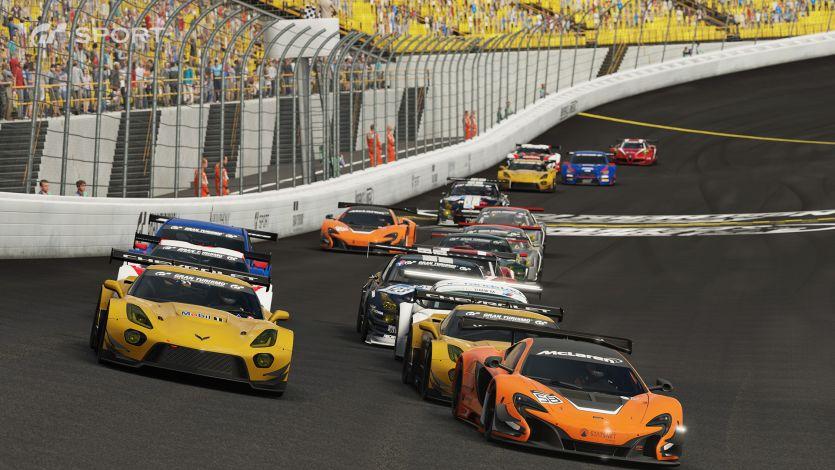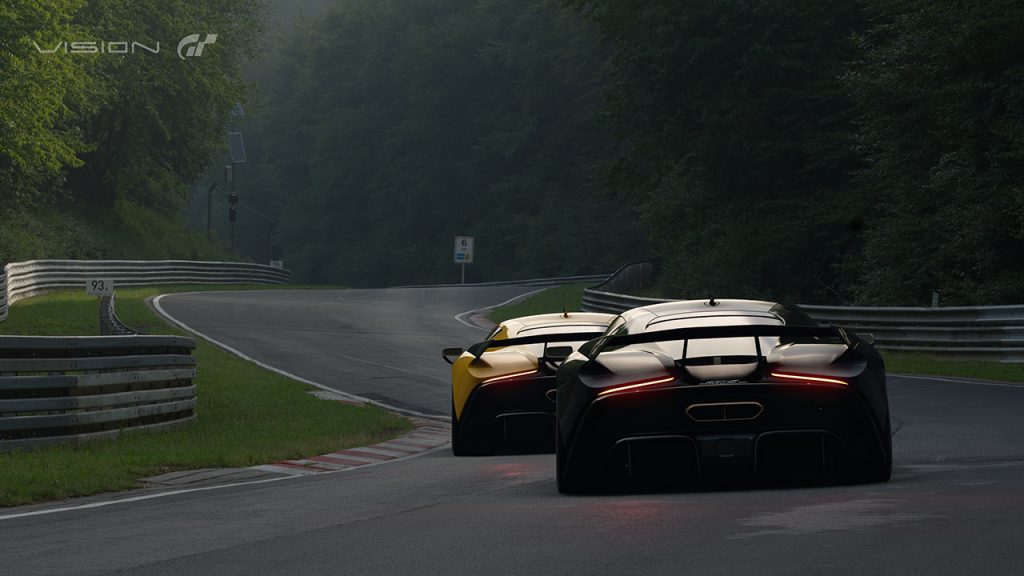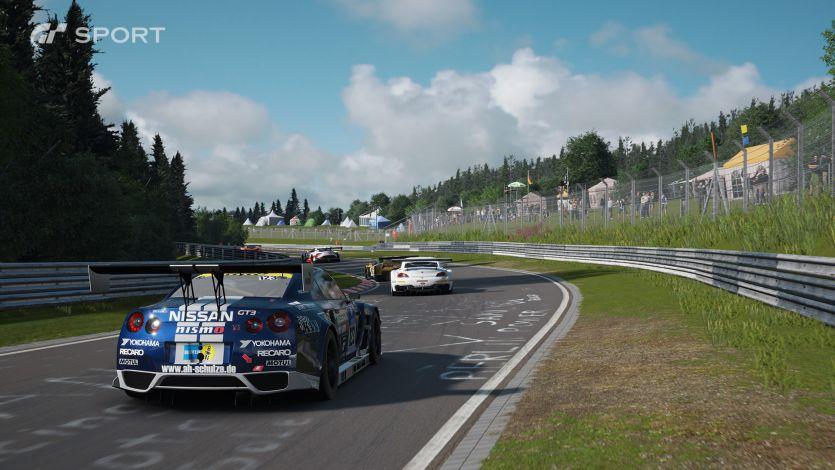
“Driving is for everyone.” Those are the first, and only words, in Gran Turismo’s opening video. You’d be forgiven for thinking it was real; that’s how good some parts of it look, especially the cars. There’s soft music and rolling landscapes, wide shots of beautiful automobiles tearing down back roads and jockeying for position on the track. Gran Turismo has always been a celebration of the beauty of cars and the thrill of driving them. “Driving is for everyone,” the video proclaims, and after spending any length of time with Gran Turismo Sport, you’ll know Polyphony Digital believes every word, and you’ll probably believe it, too.
I’m embarrassed to admit I’ve never really played a Gran Turismo game before. I love cars, and typing that sentence feels like being a film snob who admits he’s never seen Citizen Kane. I knew about it – about the massive number of cars and tracks and weird eccentricities that were unique to the series – but I’d never sampled it myself for any serious length of time. My experience was limited solely to demos and the odd race against a friend. Luckily, Gran Turismo Sport is an excellent place for newcomers to start.
" Each and every one of the 162 cars here features Polyphony Digital’s fabled attention to detail. This extends to the tracks, as well, which look stunning, bre-baked or not, and the game’s clean and easy-to-navigate menus. "
The first thing anyone who is even passingly familiar with Gran Turismo will notice is how compact Sport is. There’s only 162 cars available here, a far cry from the 1,200 in Gran Turismo 6, and only 40 tracks to race on. Dynamic day/night cycles are gone, and aside from one track which features rain, weather conditions are pretty static, though there are time of day and general weather options to choose from.
To longtime fans who adore the series for its legendary scope, the amount of content on offer will be disappointing. What, you might ask, could possibly be gained from the removal of this much stuff? Consistency. Older Gran Turismo games offered a lot more, sure, but the trade-off was that “standard cars,” whose models had been built in the PS2 era, stood alongside “premium” models. At best, this was distracting. At worst, it was an eyesore.
That is no longer the case. Each and every one of the 162 cars here features Polyphony Digital’s fabled attention to detail. This extends to the tracks, as well, which look stunning, bre-baked or not, and the game’s clean and easy-to-navigate menus. Sport is, with a few exceptions (certain tracks look like they’re made of plastic, trees are hit or miss) a gorgeous video game. The sound design benefits, too. Each car has its own unique growl, which adds character and provides much needed audio feedback while racing. In the wrong gear, taking a turn too fast, or hitting a bump too hard? Your car will let you know.
"Which brings us to the driving. Gran Turismo has always marketed itself as “The Real Driving Simulator,” and having spent hours with Sport, I finally understand why."
Which brings us to the driving. Gran Turismo has always marketed itself as “The Real Driving Simulator,” and having spent hours with Sport, I finally understand why. The feedback from the road isn’t quite as sharp as, say, Project Cars 2, but it’s damn close, and it’s easy to determine when you’re taking a turn too fast and what you have to do to correct it. Frankly, when the driving feels this good, any shortcomings here are minor. The handling in this game is superb, and more impressively, every car feels unique. You can feel weight shift in each car as you take a turn and each car will take the same turn differently.
The Mazda MX-5, for instance, isn’t fast, but it handles like a dream and it’s a blast to take a sharp turn at speed and watch the little car devour it with ease. The Dodge Viper, on the other hand, accelerates like it’s on fire and needs to slow down significantly for turns, so races consist of going as fast as you can as long as you can, then furiously braking so you don’t slam into a wall, and doing it all again. And then you get into the GT3 and GT4 cars, whose handling at speed and sheer power make the road cars, even the fast ones, look exceptionally pedestrian. These are track cars, and you’ll never forget that while driving them.
The increased focus on racing means that many of the cars you’ll see are either GT cars or street legal race cars. This isn’t necessarily a bad thing, but it does mean that your options from most manufacturers are limited, and that many of the cars are just different versions of the same machine. Chevrolet’s GT cars are just another version of the available street legal Corvette, and Jaguar’s (three) cars are all some variation of the F-Type. With one notable exception, the oldest car in the game is from 2009. Sport isn’t concerned with being an encyclopedia of automotive history. Instead, it wants to teach you how to race, and race well.
" Sport doesn’t just want to teach you how to play Gran Turismo. It wants you to understand what’s happening when you drive and expects you to use that knowledge to become a better driver."
To that end, the single player campaign is focused on teaching you to drive. You see, Sport doesn’t just want to teach you how to play Gran Turismo. It wants you to understand what’s happening when you drive and expects you to use that knowledge to become a better driver.
Much of this is done through the exceptionally punishing driving school, which will teach you everything from how to stop in a certain place to how centrifugal force acts on your car, and you should use that knowledge to take turns. Acquiring the full slate of gold medals requires precision and hard work, and some of the challenges are maddeningly difficult. You’ll spend a very long time just trying to take a turn a tenth of a second faster, but the process will make you a much better driver. Polyphony evens includes narrated tutorial videos for each challenge to help you out. They’re good, but they’re also hosted on YouTube, which means they can take anywhere from a few seconds to half a minute to load.
There are also driving challenges, which are designed to test you on very specific situations – passing someone while you have limited fuel or time, for instance – and circuit challenges, which task you with mastering a track section by section, and then putting it all together for the perfect race. Naturally, there are assists for those of us who need them, the coolest being that the driving line now marks entry, apex, and exits points for turns, and leaves you to figure out the rest.
"While Gran Turismo wants you to be a good driver, it also expects you to be a good sportsman, so much so that it forces you to watch videos on “Driving Etiquette” and sportsmanship before you can play online."
Sure, there’s an Arcade mode that lets you do offline races, time trials, custom races, drift trials, and local multiplayer races, but the real point of all of this teaching is to get you online, which is where Sport really shines. You can enter a lobby at will and race however you like, but you won’t earn any reputation unless you enter the daily races or participate in one of the championships, which are FIA-recognized. This is Sport’s real appeal, and the game keeps you racing even while you’re waiting for an event to start, allowing you to post more qualifying lap times.
While Gran Turismo wants you to be a good driver, it also expects you to be a good sportsman, so much so that it forces you to watch videos on “Driving Etiquette” and sportsmanship before you can play online. In addition to a skill rating, you’re also assigned a safety rating, which punishes you for hitting walls and other drivers, and going off track. Keep it clean, and your rating will rise, allowing you to race against other skilled players. Keep messing up, and it will fall. Your skill rating is also tied to your safety rating, meaning you can’t work your way up the ranks without being appropriately safe, so there’s incentive to drive well. There’s flaws with this system – if one player hits another, both of their safety ratings take a hit – but it largely works well, and gives the online races, which are already smooth and exciting, even more weight.
If you get tired of racing, you can always check out some of Sport’s curated content, which runs the gamut from museums explaining the history of most manufacturers to videos about their cars. These are great little history lessons that give insight into how these companies formed and evolved, but there are some glaring omissions. Ford, Chevrolet, and Dodge, for instance, have no museums at all, which is baffling given the history of those companies. Others have little video content. If that’s not your speed, you can enter Scapes mode, which lets you snap pictures of your cars in various places around the world, complete with every conceivable aesthetic tweaking you might desire.

"If Sport has one glaring flaw, it’s that the game takes away your keys if the server goes offline or if you lose your Internet connection. At that point, the only thing you can play is Arcade mode. You can’t take pictures, buy cars, or even play the campaign. You also can’t save any progress you make. "
If Sport has one glaring flaw, it’s that the game takes away your keys if the server goes offline or if you lose your Internet connection. At that point, the only thing you can play is Arcade mode. You can’t take pictures, buy cars, or even play the campaign. You also can’t save any progress you make in Arcade mode until you’re back online. This is likely to prevent cheating, but it’s reminiscent of the worst kind of DRM and it’s a slap in the face that Polyphony doesn’t trust you to play the game you purchased unsupervised. Like most modern games, Gran Turismo Sport is beautiful and well-crafted, but it never lets you forget that this is Polyphony’s world, and you’re only allowed to play in it when and how they let you.
There are other niggles. The damage modeling is nearly non-existent and crashes often feel weak – until they don’t. All of this, however, pales before the simple fact that Gran Turismo Sport simply feels good to play. Driving like this, in a video game, is a rare and beautiful thing, and Polyphony has delivered a beautiful game that loves it as much as you do. Polyphony has been tight-lipped about how additional content for Sport will be delivered, but it’s an excellent foundation upon which to build. I entered Gran Turismo Sport with no attachment to the series; I’m leaving it as a fan who will be coming back. Driving is for everyone indeed.
This game was reviewed on the PlayStation 4.
Excellent driving and handling. Good sound design. Beautiful cars and tracks. Campaign will make you a better driver. Plenty of ways to play online and off. Online racing is smooth and emphasizes good racing.
Only 162 cars. Few dynamic weather options. Tutorial videos can take a while to load. Weak crashes and damage modeling. You can't perform basic functions without being connected to the servers.





















